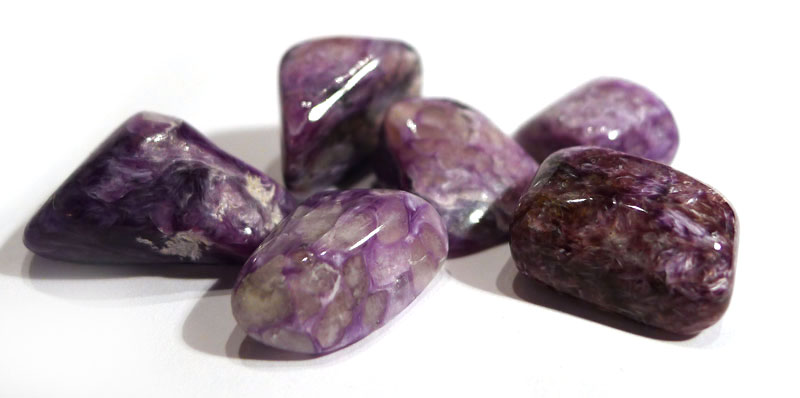Properties:
Charoite connects the emotional Heart with our spiritual dimension, making it easier to bring spiritual thoughts and beliefs into the physical realm. Melody calls it “a stone for this age”, citing this synthesis between Heart and Crown Chakras. Crystal therapist and author Michael Eastwood has called charoite “the acceptance stone” (a quality Melody also mentions with regard to the acceptance of others). This acceptance occurs on every level, so can be the acceptance of difficult experiences in our lives, unpalatable truths, our own Shadow, or on a more positive note, spiritual truths we cannot prove through intellect – and of course, acceptance of others, even when we are at very different stages of development. One friend, a mineral dealer who did not believe in the esoteric use of crystals, told me all of that changed when he held a charoite palm stone – he found he was not only able to believe crystals would heal, but could understand on some level how they did so.
In addition, charoite is profoundly calming, and can be used to treat sleep disorders. I have also heard of its use to stimulate dreaming and lucid dreaming. In addition, it supports the immune system and strengthens the body’s ability to heal, as well as cleansing and clearing the upper chakras and energy body. Naisha Ahsian recommends charoite to enable us see our life path, and help prevent transference/countertransference between practitioner and client.
Black or dark green aegerine inclusion helps to ground its spiritual energy, and further supports and enhances charoite’s work.
Attributes:
- Chemical Formula: (K,Sr)15-16(Ca,Na)32[Si6O11(O,OH)6]2[Si12O18(O,OH)12]2[Si17O25(O,OH)18]2(OH,F)4 · ~3H2O – shall we just say “complex chemistry”?
- Group: Silicates – inosilicates
- Crystal System: Monoclinic
- Hardness: 5-6
- Birthstone: Secondary birthstone for Sagittarius and Scorpio
- Chakra: Third Eye; affects Heart and Crown
- Element: Spirit
Mineralogy:
Charoite is a rare mineral with only one known location: Murunskii Massif, Chara and Tokko Rivers Confluence, Alden Shield, Sakha Republic, Eastern-Siberian Region, Russia. It has a complicated chemistry, and forms in fibrous masses of violet to deep lilac, through metasomatism (the altering of mineral chemistry during the metamorphic process) in potassic feldspars. ‘Extra’ grade material (see main photograph) was taken during the early stages of mining, but there is little of it left. Charoite is used primarily for decorative pieces, which are produced mainly by the state-run lapidary factory, so unpolished pieces are difficult to come by. Examples will often contain other minerals, notably aegerine (black to dark green, often in radiating fibres), clear quartz grains, rounded pale green grains of microline (amazonite), and white barytocalcite – all of which will affect the energy.
History and Tradition:
Charoite was discovered in 1978, and named after the type locality near the Charo River in Eastern Siberia. Because of its recent discovery, there are no traditions associated with this mineral.




